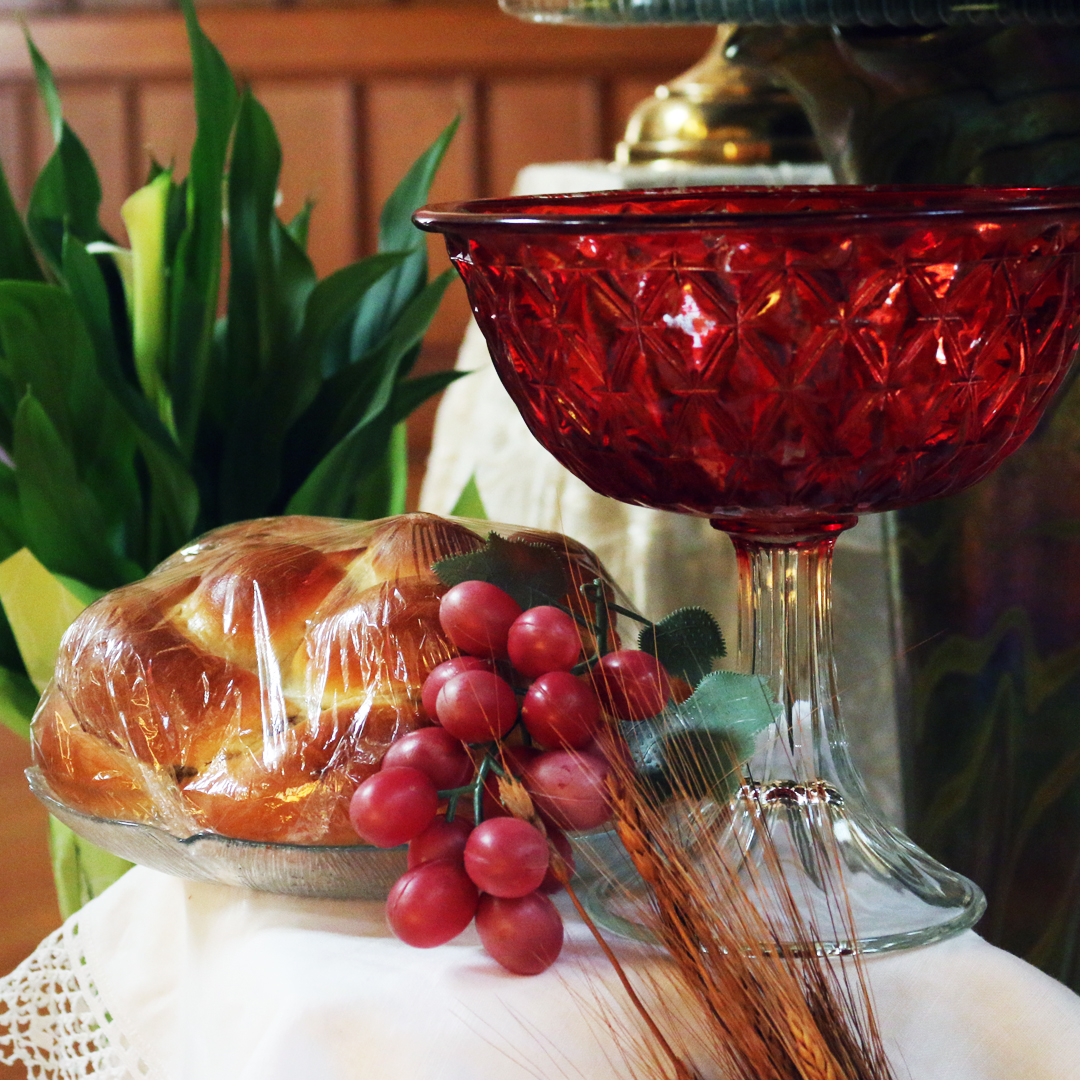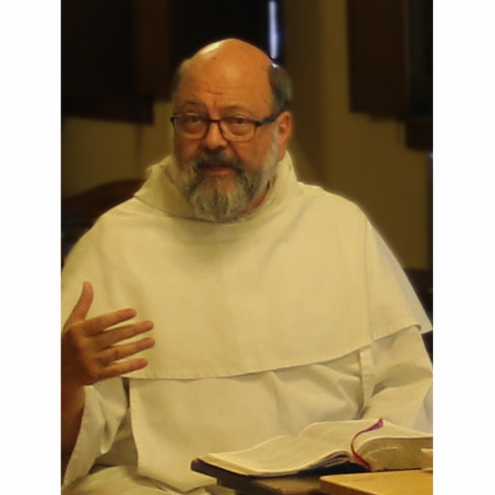Refectory Reading Review: Lectio Mary
As Catholics, what we believe about Mary is rooted in Jesus, and as we deepen our relationship with Mary, she always leads us to her Son, Jesus. This is even more vital during these times in which we live. We need to cultivate our relationship with our Mother Mary, who is the new Eve, the Mother of the Messiah, our Queen, and the Mother of Sorrows. Here’s one series that can help us do just that.
Our community has been the blessed beneficiary of recorded content produced by The Augustine Institute. Most recently, we listened to Lectio Mary: The Bible and the Mother of God as part of our meal reading. There was so much engaging material presented in this series, that listening to it once was not enough; a group of us met weekly to go through the series again as a group lectio exercise, following the accompanying workbook. If you want to know why Mary is so important to Catholics or want to deepen your relationship with Jesus and Mary, this series is for you.
The presenter in the series is Dr. Brant Pitre, Distinguished Research Professor of Scripture at The Augustine Institute. He received his Ph.D. in New Testament and ancient Judaism from the University of Notre Dame, Indiana and focuses his teaching and writing on the Bible and on the Jewish roots of Scripture and Christianity. Over the course of eight sessions, averaging 30 – 40 minutes each, Dr. Pitre explores seven different aspects of Mary by examining the Old and New Testaments, as well as teachings by the Church Fathers. He clears up many misconceptions about Mary and explains what the Catholic Church believes and teaches; his approach to these issues is clear and understandable while remaining very engaging.
The accompanying workbook gave the lectio group great questions to help facilitate study, meditation, and discussions on the material presented in the sessions. There were many things presented through the sessions and questions asked in the workbook that were new to some of us, or the topics were approached in a unique way, which made them all the more richer in application to our spiritual lives.
As Catholics, what we believe about Mary is rooted in Jesus, and as we deepen our relationship with Mary, she always leads us to her Son, Jesus. This is even more vital during these times in which we live. We need to cultivate our relationship with our Mother Mary, who is the new Eve, the Mother of the Messiah, our Queen, and the Mother of Sorrows. This Saturday is the Feast of the Presentation of Mary in the Temple, a day we can imitate her example in presenting ourselves to God. Next month, with Advent and Christmas, is the perfect season to grow closer to Jesus through Mary. We cannot recommend this series enough for those looking to deepen their love for Mary and gain a clearer understanding of her proper role in our lives as Christians.
Beautiful Preaching: Fra Angelico, the Arts and Iconography
Fra Angelico was an examplar Dominican preacher - he sought the face of God in contemplation, gave Christ his entire being and became an instrument in His hand to preach the Gospel and draw people to Himself through the beauty of his paintings and frescoes. This too is the way for the nuns of the Order of Preachers. Our community has, from its beginning, had a tradition in the visual and musical arts, which has blossomed through the course of time in various ways: producing vestments and ecclesiastical linens, Gothic calligraphy and illuminating manuscripts, fine artwork, photography and digital design, and most recently iconography.
To preach the Gospel, words are not always necessary. Today we remember a Dominican friar who remains one of the most renowned artists of all times: Blessed John of Fiesole, more popularly known as Fra Angelico. Fra Angelico was known to frequently say, “If you seek to do the work of Christ, you must live with Christ.” Fra Angelico was an examplar Dominican preacher - he sought the face of God in contemplation, gave Christ his entire being and became an instrument in His hand to preach the Gospel and draw people to Himself through the beauty of his paintings and frescoes.
This too is the way for the nuns of the Order of Preachers. And as each individual is given charisms for the building up of the Church, it is not uncommon to find monastic communities have general charisms as well, both for preaching some particular aspect of the Gospel and often to help support the community: some communities excel in gardening and the use of natural resources, some in various crafts and the production of goods, and so on. Our community has, from its beginning, had a tradition in the visual and musical arts, which has blossomed through the course of time in various ways: producing vestments and ecclesiastical linens, Gothic calligraphy and illuminating manuscripts, fine artwork, photography and digital design, and most recently iconography.
Last fall, our community had an extraordinary opportunity to begin learning an ancient form of prayer and preaching: iconography. Several of our younger sisters have had a desire to learn more about iconography (writing icons) and iconology (the study of icons) and, through the workings of Divine Providence and the generous support of benefactors, several sisters in our community spent a week in an intensive icon retreat with iconographer Kristina Sadley of Prophecy Designs Icons and an affiliate instructor for the Prosopon School of Iconology.
“Icon” is Greek for “image” and traditional icon writing is a prayerful discipline of hand, heart, and mind to bring forth the “Gospel in color” – every canonically written icon reveals Christ, and comes from within the iconographer and his/her prayer.
The week began with Mass, confession, and a blessing of our icon boards and our sister iconographers. Once in our “iconography studio”, we began each morning with prayer, giving glory to the Holy Trinity, asking for grace and illumination as we worked and interceding for those who would venerate the icons we were writing. Except for instructions, our time was largely spent in silence.
We quickly learned that everything in iconography has meaning and purpose – every feature, every color, every step in the process. For example, the wood of the board – a symbol of the wood of the cross; the whiteness of the board – purity and light. Our first step was to trace the image of our icon onto the board using carbon paper, then, once traced, we etched into the white gesso layers with a stylus so our lines would not be lost as we began to apply clay, gold and pigments. This parallels our own life when we receive the Gospel – lightly at first, but when we cooperate with God’s grace, He etches His Word into our hearts.
The next step was also profoundly meaningful to many of us – applying the clay bole and the goldleaf for the icon’s halo. The clay bole represents our humanity. The gold represents God’s glory and divinity. To have the gold adhere properly to the clay, the iconographer must get very close to the clay, with goldleaf piece ready in hand, and breathe deeply but gently on the clay to warm it, reminding the iconographer that God breathed life into Adam. After two or three breaths, the gold is quickly applied and pressed gently onto the warmed clay, and the iconographer moves to the next small section of the halo to begin again. Once the gold is applied, the first color is applied to the board – a bright red line is added to encircle the halo – the blood of Christ and the white has now been broken open into color.
So by now you may be asking, “which icons did the sisters write?” Mary? Jesus? A festal scene? You may be surprised (as we were) to learn we had no choice about our first icon – we would all be writing Saint Michael. But then, Kristina explained why: iconography, as prayer, is a battle – it is spiritual warfare in a profound way. And so we begin with Saint Michael, who is prince of heaven and our help in spiritual battles against the devil. Saint Michael reminds us, “who is like God?” He helps us keep right perspective in humility and our eyes Christ. It is also for these reasons that an iconographer does not part with his or her first icon.
Our first icon completed, our new iconographers are making plans to begin writing their second icon, Saint Gabriel. As Saint Michael helps us grow in humility and clear out the sins and blocks in our hearts and lives to God’s grace, Saint Gabriel brings the Good News and helps us fill our souls with God’s goodness, truth, and beauty.
We give thanks to Kristina and our benefactors whose generosity opened the door for us to this ancient method of prayer and visual preaching of the Gospel. May Fra Angelico intercede for all artists and those who use visual means to promote the goodness, truth and beauty of the Gospel. Saint Michael, Saint Gabriel and Fra Angelico, pray for us!
Want to learn more about assisting our arts and iconography studio or other opportunities to support our cloistered Dominican life? Email us or visit our website. Thank you and God bless!
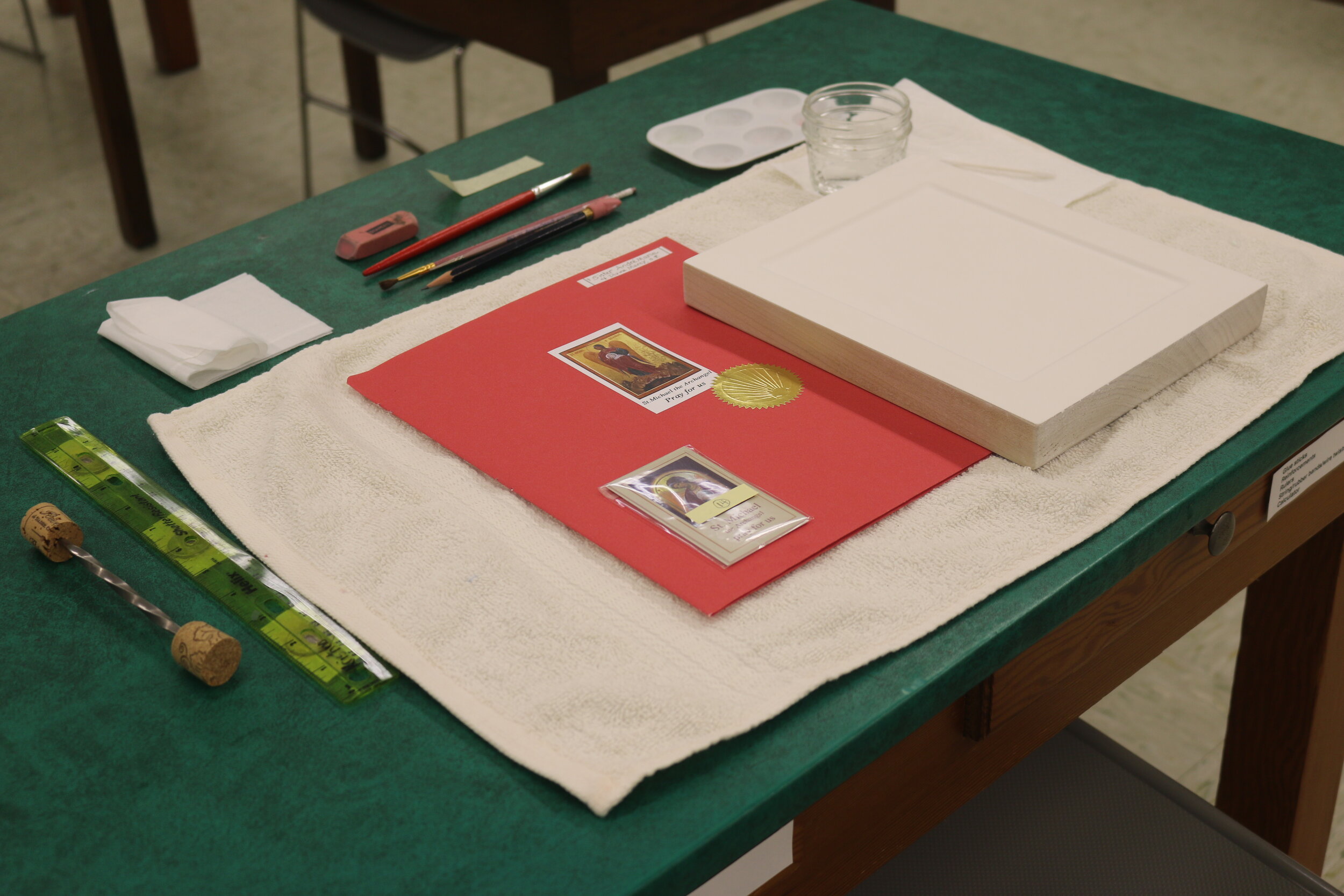
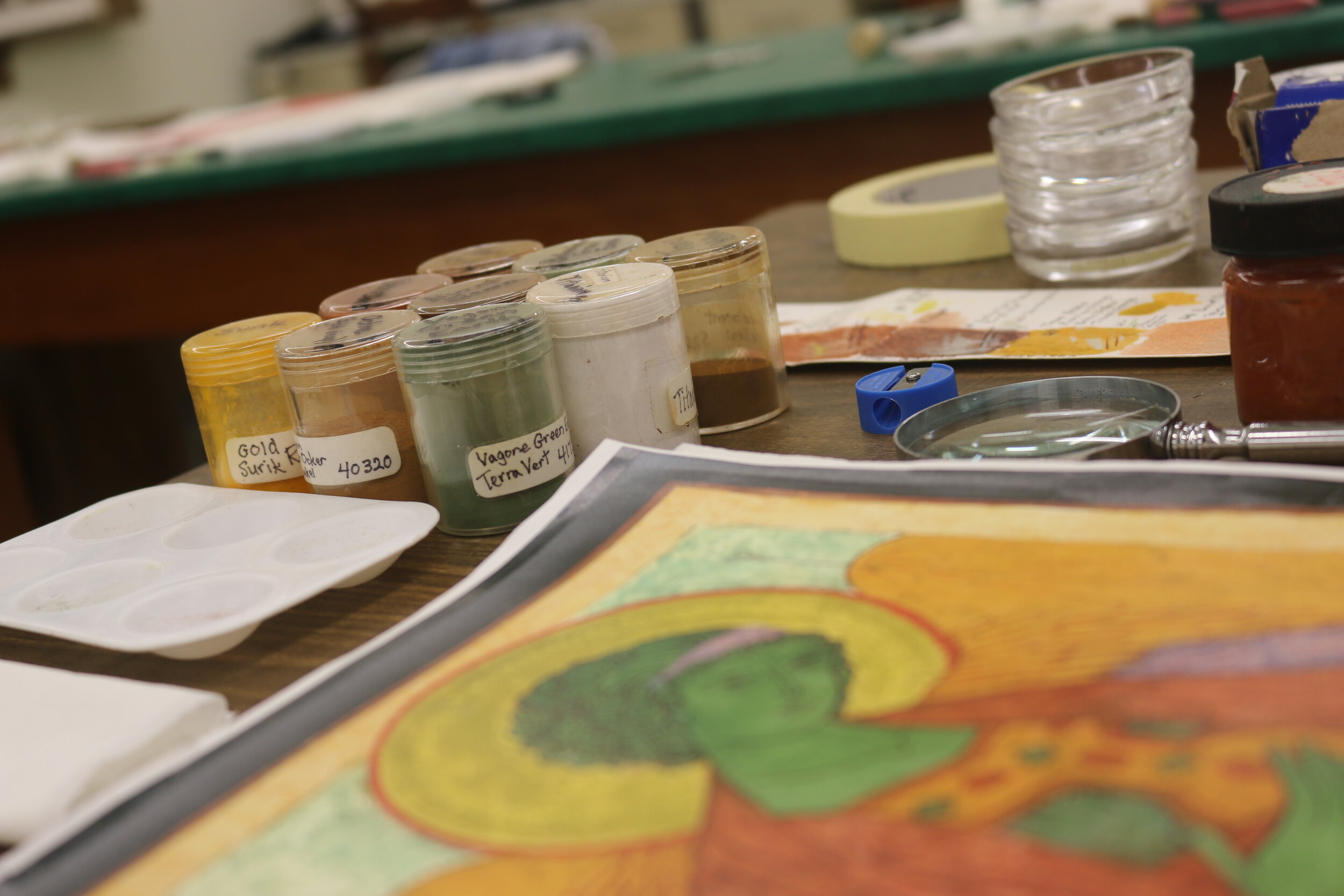
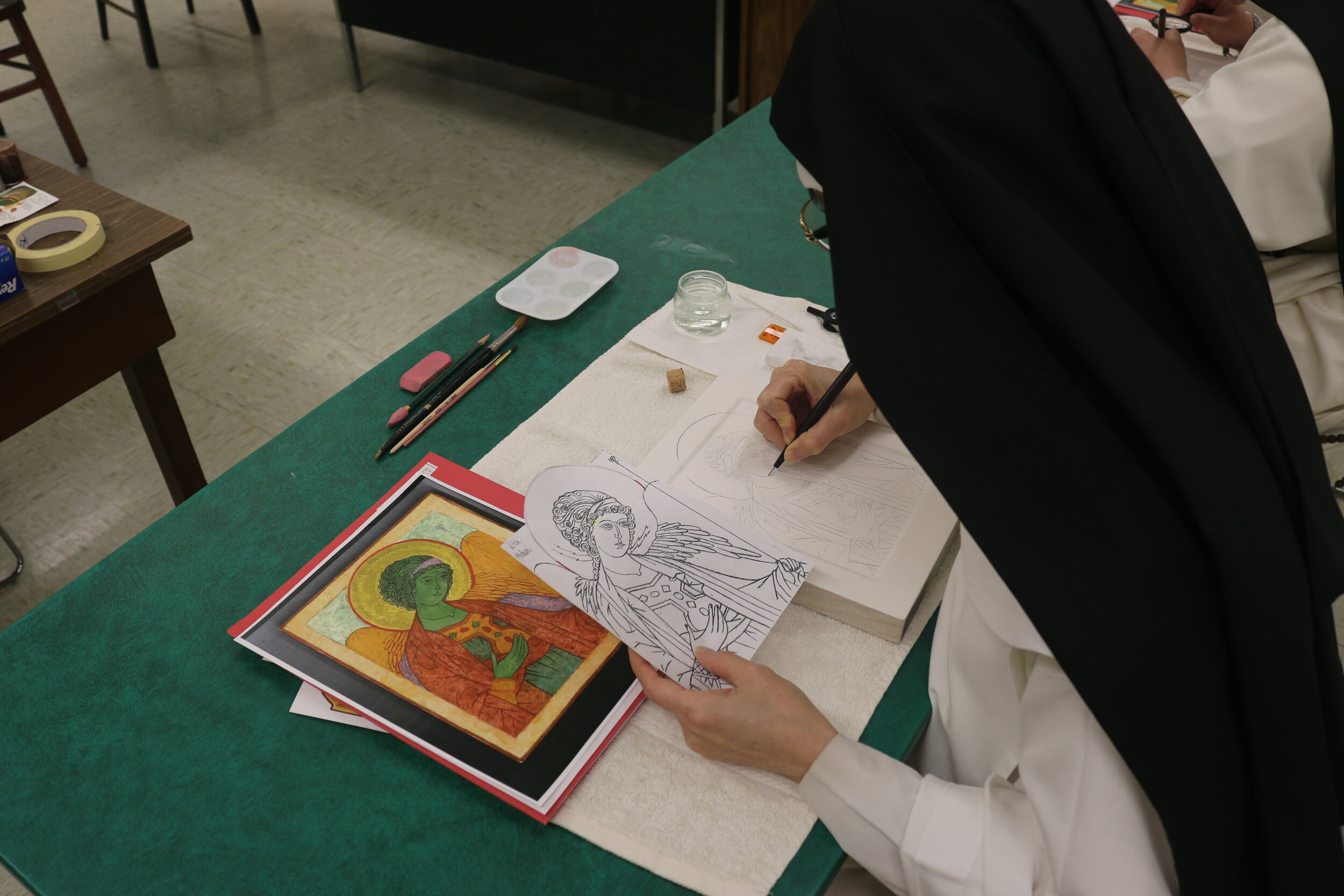
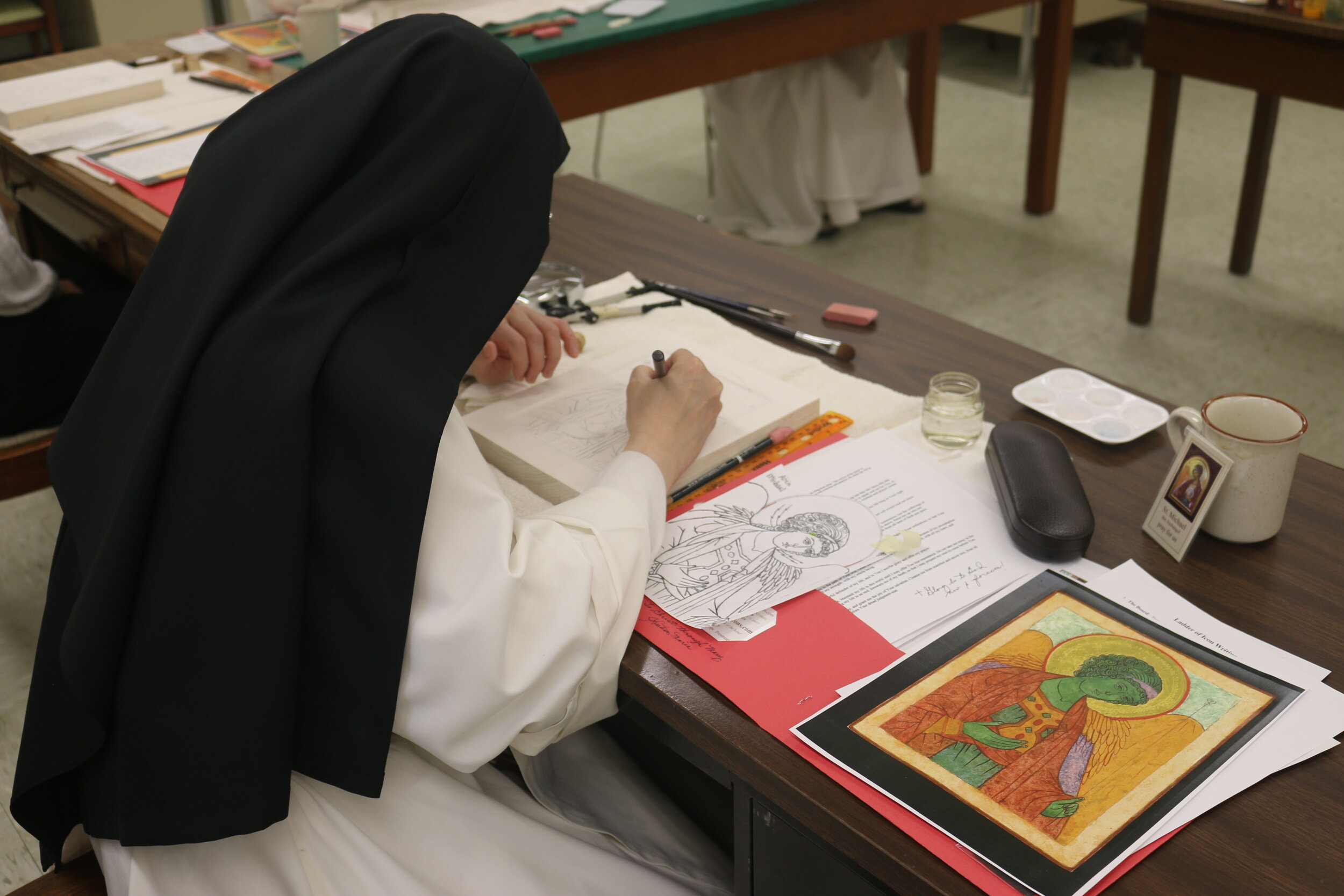
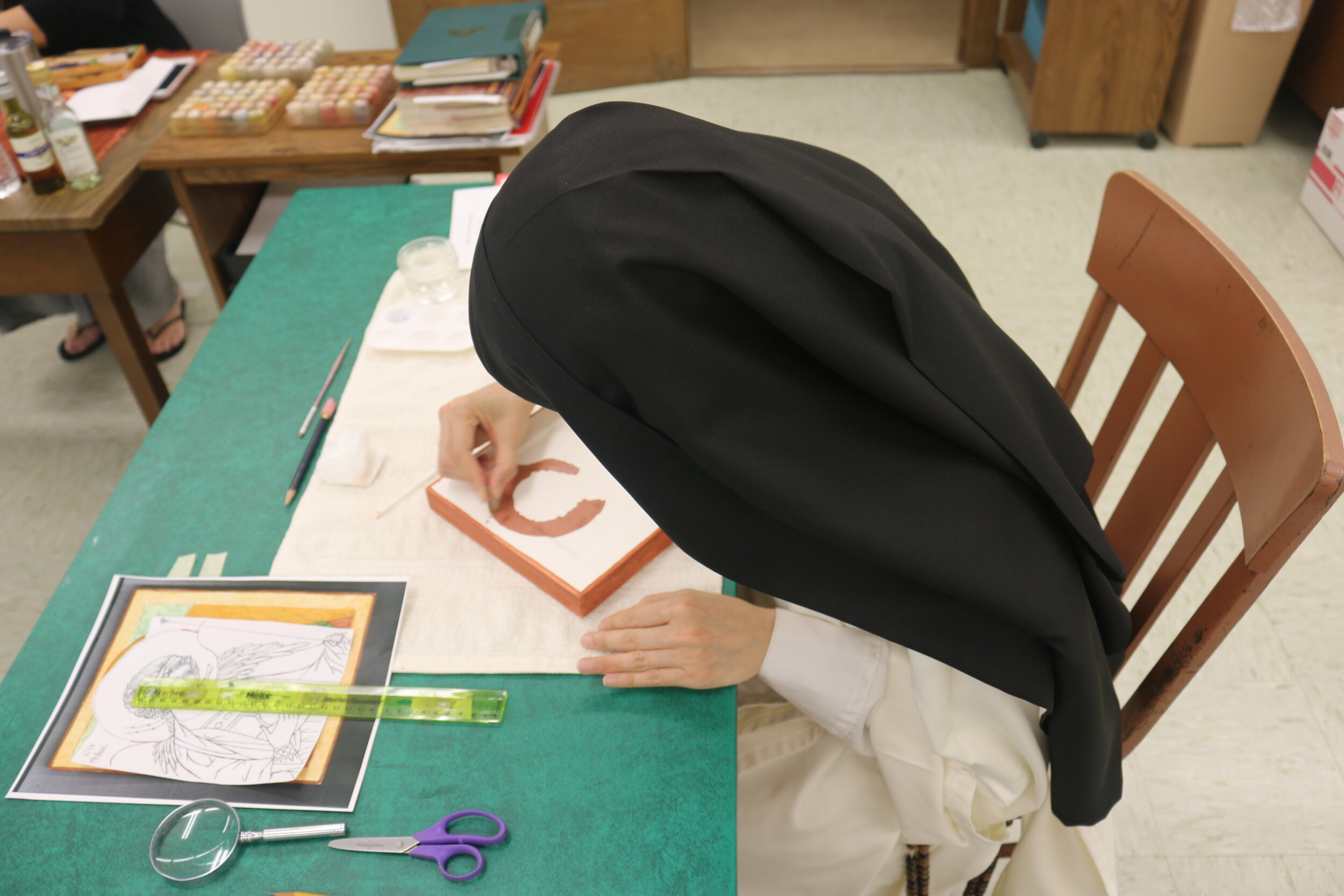
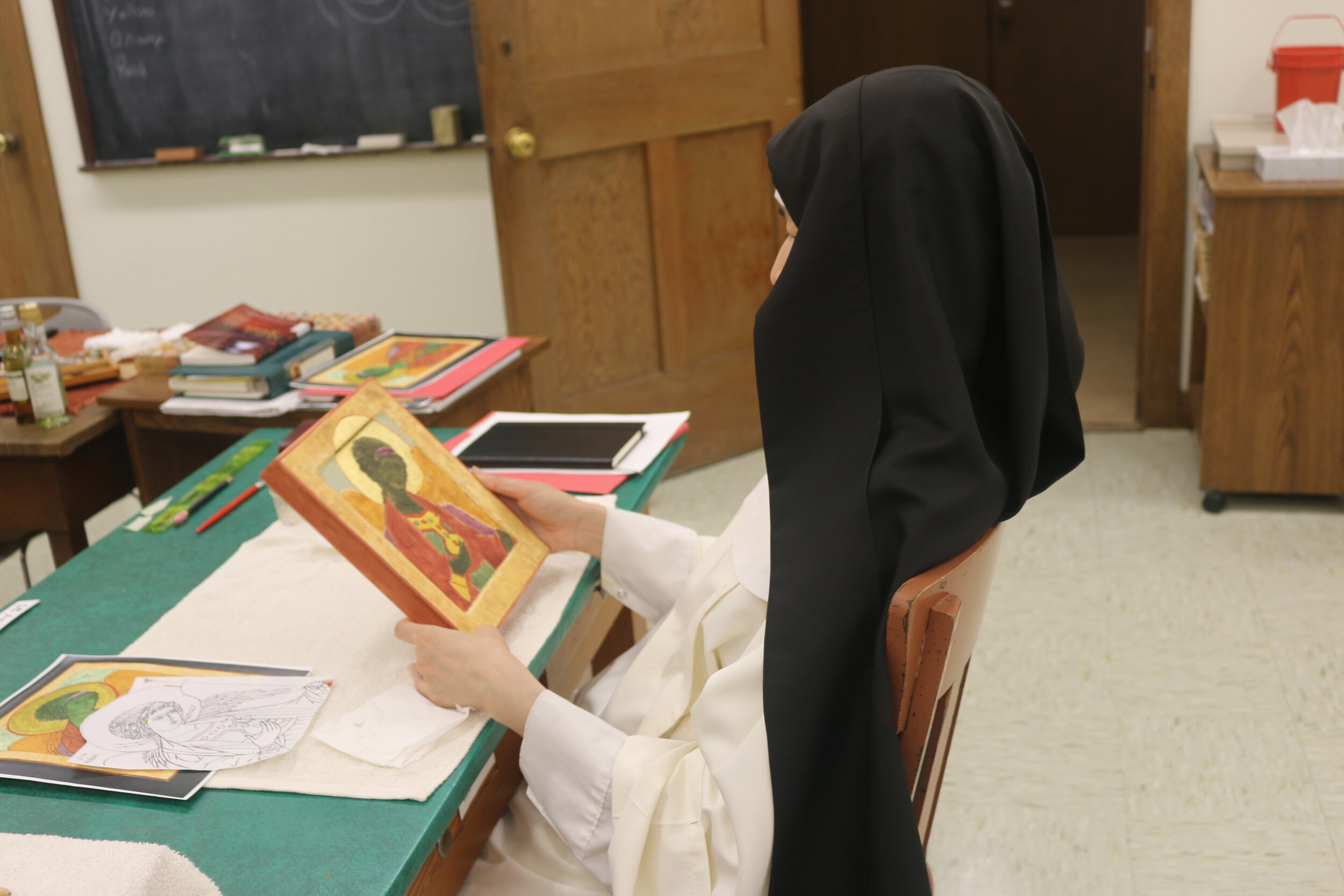

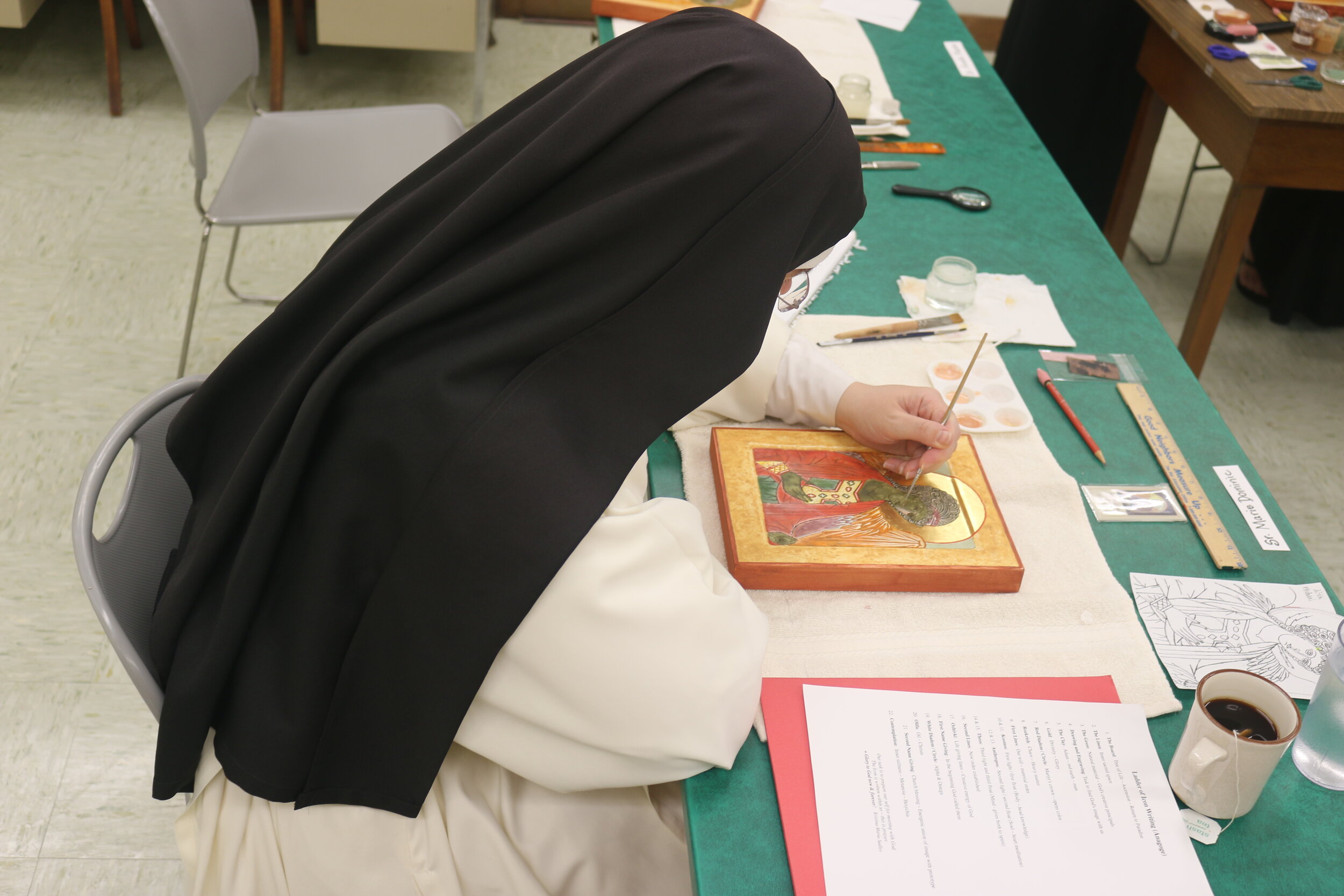

To Be[come] a Preacher
Why do we study? To know better He whom we love. This past summer, our sisters-in-formation headed to Lufkin, Texas to begin a four-year study program in philosophy and theology. In this post, they give a description of their experience and impressions.
Our Monastery of Corpus Christi in Menlo Park, California was still wrapped in the stillness of night as we four sisters-in-formation made our way to the choir for a visit with Jesus, then slipped quietly to the kitchen. Our novice mistress and another sister were busy preparing sack lunches and a good breakfast of eggs and toast to send us on our way. Hugs and good-byes exchanged, we loaded up into the waiting van and headed to the San Francisco International Airport to catch a flight to Houston, Texas, where we would meet five other sisters-in-formation from across North America. Our ultimate destination was the Monastery of the Infant Jesus in Lufkin, Texas - a two-hour drive from Houston - to begin our first year of the Monastic Theological Program with a two-week session of classes in Philosophy and Theology.
Monastic study is not like studying for school or a career - we study God and the things of God to know Him better so we might love Him more, and more effectively share Him with others.
The Monastic Theological Program, or MTS, is offered by the North American Association of Dominican Monasteries (NAADM) for nuns who have professed, or will shortly profess, simple vows. It is a four-year program of philosophical and theological studies intended to introduce the nun-in-formation to more advanced study that we can then pursue for the rest of our monastic life. Each year begins with a two-week session of intensive classes taught by Dominican friars. This year, the first week was an introduction to philosophy taught by Father Brian Chrzastek, O.P. of the Province of Saint Joseph; the second week was an introduction to theology taught by Father Philip Neri Powell, O.P. of the Province of Saint Martin de Porres. After the two-week class session, we return to our own monasteries to “unpack” what we received, write topic papers, and prepare presentations to be given to our classmates at the following year’s two-week session. But MTS is more than just a program to sharpen our Dominican pillar of study. It also provides exciting opportunities for a nun to grow in the pillars of prayer, community and preaching.
Through the Monastic Theological Studies program, nuns-in-formation share a valuable experience of Dominican life in other monastic communities and begin building community with one another.
For this four-year cycle of MTS, four monasteries of NAADM sent sisters-in-formation to participate: one sister from the Monastery of the Infant Jesus in Lufkin, Texas, one sister from Queen of Peace Monastery in British Columbia, Canada, three sisters from the Monastery of Our Lady of the Rosary in Summit, New Jersey, and four from Corpus Christi Monastery, in Menlo Park, California. Those of us who traveled from the other three monasteries, traveled an average of 1,960 miles, or 3,110 kilometers. That’s farther than driving from Rome to Moscow!
For most of us, this was the first time we’d visited another Dominican monastery other than the one we entered. And, because our homes and monasteries are situated in vastly different regions of North America, we also have different cultural experiences and ways of expressing the values of Dominican life. Some of our monasteries are older (for North America) and were built in in a more classic European monastic style, with stained glass windows, an enclosed cloister, Gothic arches and other architectural details. Other of our monasteries were built more recently, in a more modern architectural style, and have taken into account resources available and the contemporary needs of the local community. Our respective horaria and details in observances also reflect the needs of our respective communities. So it was an enriching experience to see Dominican values lived in another monastery and hear stories from one another about each other’s home monastery.
One of our first activities was to take a tour of the monastery and meet some of the sisters. We delighted to see and learn how many things were the same as “home” and intrigued by differences. It wasn’t uncommon to hear as we went, “oh, that’s a great idea!” or, “this is how we have this arrangement, etc.” We also grew eager for the opportunity to see another of our four monasteries – next year, the community at the Monastery of Our Lady of the Rosary in Summit, New Jersey will host the MTS classes.
But beyond architecture and the structure of the regular observances, the two weeks gave us a wonderful and unique opportunity to meet and begin to form bonds with each other. While our monasteries are autonomous, no monastery exists in a vacuum - we relate to one another and share with one another our time, talents and resources primarily through our association membership. Recently, the pope and our Master have emphasized the increasing importance of interdependence between monasteries and the developing role of Federations/Associations. Naturally, if we are to effectively share the fruits of our contemplation with each other and provide needed support and collegiality, we first need to know and begin to understand one another. Our MTS experience also gave us the opportunity to concretely realize “I am not alone.” That is, there are other sisters-in-formation who are experiencing the same difficulties, challenges and blessings that come with being formed as a Dominican nun.
When a young woman enters a monastery as a postulant, it is expected there will be a learning curve, especially at community prayer - when to bow, when to knee, sit, sing - everything is governed by certain rubrics that can vary from monastery to monastery. And so, our first time in choir for liturgical prayer was, in some ways, like returning to the postulancy. The content of the prayer, naturally, was the same, but the intonations, and the details of the way the prayer was expressed was different for most of us –the configuration of the choir, the procession flow for communion, using English versus Latin for some of the hymns and prayers, etc. The hosting community was exceedingly gracious in providing us the guidance we needed to participate more fully and soon we were, more or less, in the flow of things again.
All this gave us an opportunity to deepen our understanding of the essential values of Dominican life versus structures that can and should be adapted to time and culture. It was a beautiful experience to enter into the life of the hosting community, as much as our classes and studies would allow, and live Dominican prayer in that place. Ultimately, we can begin to see how much more we share in common than what we have in differences.
A Dominican nun’s first preaching is in her fidelity to the vows and Dominican life, which reveals the reconciliation of all things in Jesus.
We sisters-in-formation were the recipients of the most sublime preaching of our Order – the reconciliation of all in Christ. For we were welcomed with open arms, with hearts full of love (and as big as the Texas skies), and hands eager to serve and make us comfortable. We preached to each other with our common sharing and examples of preserving silence and prayer, despite our being out of our element. And we preached to all those we met along the way – the active Dominican sisters from Puerto Rico who were serving in the area and a Dominican friar from India who chanced to visit while we were there; the people in the airport and on the planes who couldn’t help but notice a group of nuns in full habit and who were eager to share their stories and ask for prayers, and many more along the way that we shall never know.
“We are preachers. It’s not what we do; it’s who we are.”
Our newly elected Master of the Order, Father Gerard Timoner, O.P., recently emphasized that “we are preachers”. It is not what we do, it is who we are. The whole experience of MTS takes a vital step in forming the cloistered nuns of North America into the preachers Jesus is calling us to be for our generation and world today.
Eight Ways We Go Astray
On the road to God and eternal happiness, there are eight common pitfalls that can trap us and keep us captive. Here’s what they are and how to avoid them.
From the earliest days of Christianity, men and women have gone out into the desert, seeking God and to “bear fruit worthy of repentance.” These Desert Fathers and Mothers are at the foundations of monastic life, and their wisdom and teachings were passed down from one monk and nun to the next. But one man systematized them into some very practical advice for those seeking God. Evagrius described for us “Eight Evil Thoughts” and stated that all our thoughts can be classified into one of these eight. And these thoughts, if left unchecked, keep us from true prayer, lead us away from God and take us down paths were we “do what we don’t want to do and don’t do what we want.” Evagrius and the Desert Fathers knew that the first step to real transformation is to know ourselves – our own thoughts and desires – and only then can we avoid the insanity of doing the same thing again and again, yet expecting different results.
These Eight Thoughts were picked up, further developed and refined by John Cassian, Saint Gregory the Great, Saint Thomas Aquinas and others to become the Capital (or Deadly) Sins many of us are familiar with today. So here’s a quick rundown of the Evagrius’ “Eight” and how to fight them.
Finally, some general remedies:
Suffer from a wandering mind? Regain focus by reading Scripture and spiritual books, spending time at night or in the early morning in silent waiting on God, and pray.
Ablaze with “flames of desire”? Quench earthly desires with fasting, regular manual labor (and/or exercise), and solitude.
Afflicted with irascibility (anger)? Calm the beast within by singing psalms (for example, the Divine Office), practicing patience, and almsgiving or works of mercy.
Of course, we can’t fight any of these without God’s help and grace, so we should always ask Him for it!
Harness Your Passion Power!
Our passions are gifts from God and He intended them to be subject to reason. But because of sin and its effects, we must cooperate with God’s grace to discipline them and harness our passion power. So how do we do this? Just remember: A.I.R.-1, 2, 3!
In a previous post, we talked about what our passions are and the purpose they serve us, that they are truly powerful (for good or evil). Our passions are gifts from God and He intended them to be subject to reason, but because of sin and its effects, we must cooperate with God’s grace to discipline them and harness our passion power.
Harness Your Power!
“A person who governs their passions is master of the world. We must either command them or be enslaved by them.” - Saint Dominic
All our passions begin with love, even hate (for example: we hate sickness only because we love health). Our passions are informed by what we’ve taken in with our senses, including our sense of imagination, our environment, our natural temperament and biology, our upbringing and past experiences, and so on. This is easy to see with food examples: we generally like the foods we grew up with and dislike the foods that are foreign to our palate. But what other things trigger our emotions? What buttons or sensitive spots do we have as a result of our temperament or past experiences that trigger anger? Sadness? Joy? Why? Each of these attitudes or way of seeing and perceiving the world around us is unique to each person.
When passions break away…
We each have one or two passions that cause us particular problems and, left undisciplined, will lead us into vice. Love and desire left unchecked can lead us into bad relationships, overeating, overspending, selfishness, and so on. Sadness can leave us depressed and immobile in life. Courage can disintegrate into recklessness. Fear can freeze us from taking risks with our talents so that we bury them. Anger can lead to harsh words or even violence. So how do we harness our power without squelching it? First, pray for God’s grace and guidance. Then, remember AIR.
Assess - where is the heart? When you start to feel your passions rise, or even as you go about the day, pause and ask yourself, “where is my heart?” We can’t harness our passion power until we know which passion is driving us at the moment.
Investigate - why? Once you’ve identified the passion of the moment, ask, Why am I experiencing this passion? What is my perception of the good and/or evil here? What is it that I really love which is at root of this passion I am experiencing at this moment? Remember our passions arise because we first perceive something as good or evil - that perception is inside us and we are ultimately responsible for it.
Respond. Only after steps 1 and 2 are we in a place to respond to the passion. If our passion is reasonable (appropriate for the time and circumstances and in the right measure), we can give thanks! If it’s not, then we need to take measures to keep them disciplined. Our responses will depend on the passion and each person, but here are three alternatives we can try.
Remind ourselves of some aspect of Jesus, Mary or the saints that shows the words, actions or virtue we want to imitate and grow.
Meditate on a mystery of the Rosary or a story from Scriptures that corresponds with the passion. Saint Teresa of Avila used to advise her sisters that if they were sad, particularly for selfish or worldly reasons, and couldn’t shake it, to meditate on Jesus’ agony in the garden and His sadness. The idea is that by giving your passion “new and better food”, it will lose it’s taste for any worldly food and will become more disciplined over time.
Use the passions against one another. This is where the passion of anger is particularly useful, because it is often not compatible with the other passions and can easily summon courage for action. If the passion we are experiencing is leading us to the point of yielding to temptation (perhaps we desire something that would not be healthy or even sinful, or we desire to do nothing when we should do something) or the passion is keeping us from peace and joy in truly good things (for example, we are weighed down by sadness or despair), then we can rouse anger to help dispel the “unruly passion” and spur us on to take any action we may need to take.
The struggle to discipline the passions is hard work, especially at first. But with grace, time and consistent practice, they begin to pull together and in line with reason. Passion Power!
Passion Power: Directing Us Toward The Good
Our passions, or our emotions, are truly powerful - they can move us, or drag us down, like nothing else! But can we harness our passion power for good and not evil?
It’s Friday night after a long week. You’re walking in the door from a long day of work. Immediately, your nose picks up a smell: pizza! Your mouth begins to salivate and your stomach growls. You want a slice (or two or three), so you head to the kitchen. Then you see an open tin on the counter and another smell hits you. Anchovies. It’s one of your roommate’s favorite pizza toppings, but you cannot stand them. You quickly pipe up to your roommate, “none for me, thank you!” and shrugging, your roommate gobbles up “your share”.
Just then, your cell phone rings. It’s your new boss and he is not happy about a project you finished today. You begin to tremble and feel defensive. You’ve been struggling at work and trying to make a good impression; as you listen to his words, your spirit sinks lower and lower - you feel powerless and immobilized and you’re mind goes numb. Then you realize he’s not seen all of your report and your heart picks up a beat with a glimmer of hope. Taking a deep breath, you gather your courage and leave the room with your phone as other friends begin to arrive. A while later, you hang up the phone. The conversation took longer than you thought, but in the end, you worked everything out - your boss is happy and you feel peace to enjoy the weekend.
Smiling with satisfaction, you remember your friends and the waiting pizza. So you walk out into the kitchen only to find… empty pizza boxes! A wave of sadness and disappointment sweeps over you, then irritation and anger begins to rise (how could they eat it all?!). Your roommate enters the room, munching on a crust. “Oh hey! We weren’t sure how long you were going to be, so we saved you some slices. They are in the oven keeping warm.” As you settle in your favorite chair with your slices (anchovy-free!) and friends all around, you sigh deeply with joy.
Our passions, or our emotions, are truly powerful - they can move us, or drag us down, like nothing else! But what are our passions? What purpose do they serve? Are they good? Should we just “follow our hearts” and let our passions lead us? Or are they so opposed to our intellect that we should try to deny and extinguish them? Can we harness our passion power for good and not evil?
Know Your Power!
As humans, we are flesh and spirit, body and soul. Our passions, or emotions, are movements of our sensitive appetite and is something we have in common with all animals. We perceive some object with our senses, we believe it to be either good or evil and a change in our physical bodies results. In our above example, we smelled pizza, we believe pizza is good and our mouths began to water and our stomach growled. When we thought our friends had eaten the pizza, thus depriving us of that good, we experienced sadness, and so on.
Thomas Aquinas describes eleven passions. Six passions incline us to seek sensible and pleasurable goods and to flee harmful evil: love, hate, desire, aversion, joy, and sadness. The remaining five passions incline us to resist obstacles and, in spite of them, to obtain a difficult good: hope, despair, courage, fear, and anger. Looking back at our story, can you spot all 11 passions?
Power For Good…Or Evil?
So are the passions good or bad? Pleasure-seekers would say, “they are good! Follow your passions! Do what feels good! That is a legitimate expression of our human nature!” Stoics, recognizing unbridled passions can lead us to act contrary to our human reason, would argue that passions should be suppressed. We, as Catholics, take the middle road: our passions are neither good nor bad – it’s what we do with them that matters. What makes them good or bad is whether they are conformed to right reason. Having one or two slices of pizza when we’re hungry is not bad! Having a whole pizza or two likely is.
Thomas Aquinas also goes further. Our passions can actually increase or decrease the merits of our virtuous acts (and do the same for the demerits of our vicious ones)! We instinctively recognize this when we watch someone doing something good, but say “his heart is not in it.” God too loves a cheerful giver, which is why we should strive to have our passions in line with right reason. So our passions should be disciplined, but not extinguished. We can think of our passions as the “horsepower” of our soul. Our passions are like a stallion, our body the chariot and our intellect the driver. If the driver does not train and guide the stallion with a firm but gentle hand, the stallion will break away and cause a wreck. Next time, we’ll talk more about how to harness this passion power!
How We Spent Our Summer Vacation, Part 5: The Labor Day Week Finale!
Each year around Labor Day, we have the privilege and joy of extending hospitality to one of our Dominican friars, Father Luke Buckles, O.P., before he returns to the Pontifical University of Saint Thomas Aquinas (the Angelicum) in Rome, where he is a professor of theology. This year, as part of his visit, we were treated to a two-session seminar on Dominican and Carmelite mystics.
Each year around Labor Day, we have the privilege and joy of extending hospitality to one of our Dominican friars, Father Luke Buckles, O.P., before he returns to the Pontifical University of Saint Thomas Aquinas (the Angelicum) in Rome, where he is a professor of theology. This year, as part of his visit, we were treated to a two-session seminar on Dominican and Carmelite mystics. Father wove together insights from St. Catherine of Siena, St. Thomas Aquinas, St. Therese of Lisieux, St. Teresa of Avila, and St. John of the Cross. One common thread that emerged was the unity of life bestowed by grace in the lives of the mystics. Each of these Doctors of the Church experienced a profound sense of God’s presence at every moment and in every circumstance, whether sacred or mundane.
While we make think that mysticism is too lofty for everyday life, Father reminded us of a few lessons from these great saints: St. Teresa of Avila taught her sisters that prayer is never interrupted by charity. If one is called out of choir to help a sister in need, there is no break in one’s prayerful union with the Lord. St. Therese of Lisieux found heaven in doing little, mundane tasks, such as picking up a pen from the floor, with great love for God and neighbor. St. Catherine of Siena is famous for her discovery of the “interior cell,” in which she constantly dwelt with God even in the midst of a crowd.
And to quote another Dominican, Meister Eckhart, we are challenged: “Don’t go around doing holy things. Make everything you do holy!”



![To Be[come] a Preacher](https://images.squarespace-cdn.com/content/v1/5a32b42d9f8dce05dea5bcea/1575139765054-K4P3II8VNZUQRVHJS31C/to+be%5Bcome%5D+a+preacher_+monastic+theological+studies+in+texas.png)







